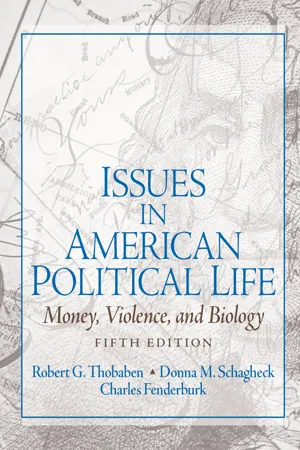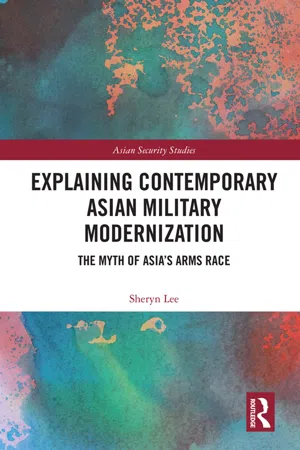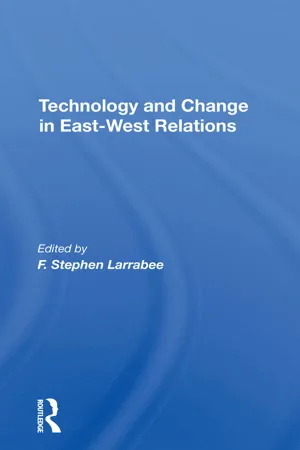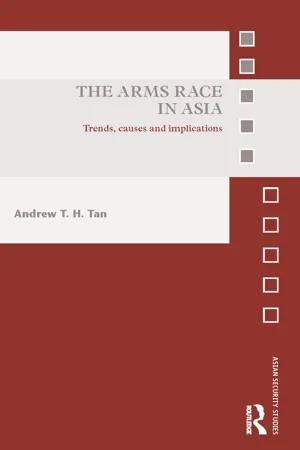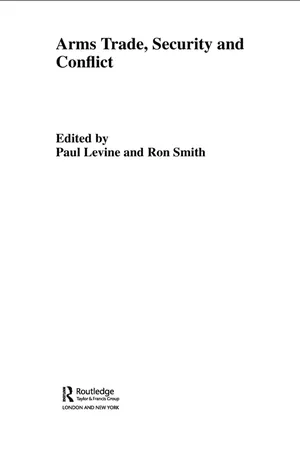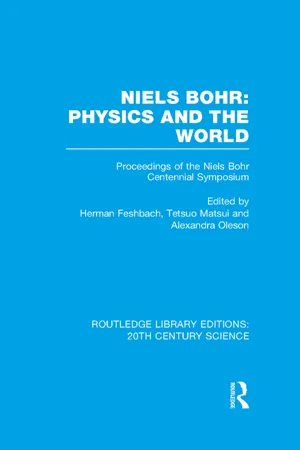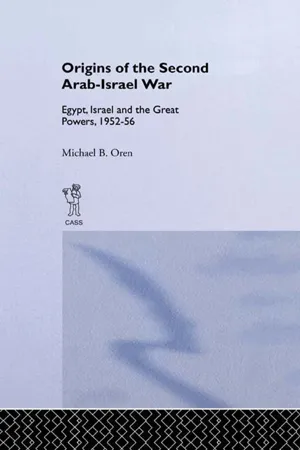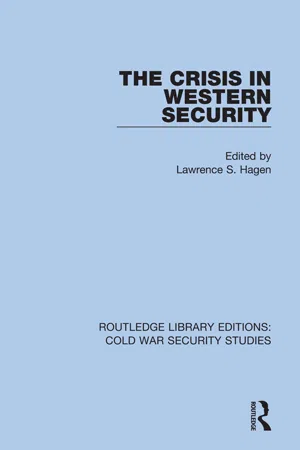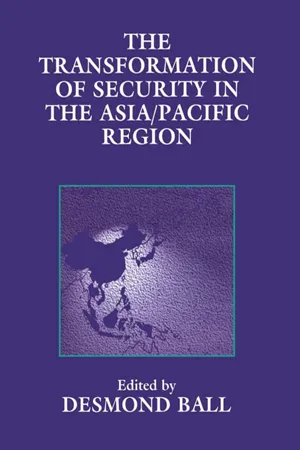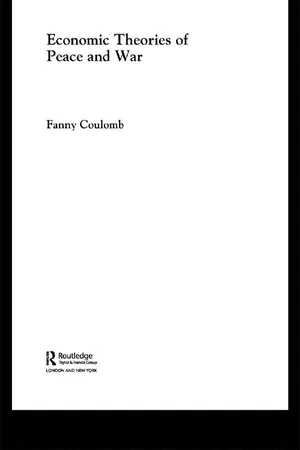History
The Arms Race
The Arms Race refers to the competitive buildup of military weapons and technology between nations, particularly during the Cold War era. This rivalry was primarily between the United States and the Soviet Union, with both sides striving to outpace the other in terms of nuclear weapons, missiles, and military capabilities. The Arms Race had significant global implications and contributed to heightened tensions between the two superpowers.
Written by Perlego with AI-assistance
Related key terms
12 Key excerpts on "The Arms Race"
- eBook - ePub
Issues in American Political Life
Money, Violence and Biology
- Robert Thobaben, Charles Funderburk, Donna Schlagheck(Authors)
- 2015(Publication Date)
- Routledge(Publisher)
The context in which world politics is played out had been changed forever by four developments: The practice of total war (such as the firebombings of Dresden and Tokyo, air raids on London, and the nuclear bombing of Hiroshima and Nagasaki) converted civilian populations and industrial bases into participants and targets of war strategies. Nuclear weapons had been developed and had proven useful and relatively inexpensive over the course of the war. Ideology (fascism, Marxism-Leninism, liberal democracy) delineated the major lines of political conflict during and after the war. The Cold War quickly took shape, embodying the ideological chasm between the remaining two power centers (the United States and the Soviet Union) and reflecting their intention to compete politically and militarily through a conventional, chemical, biological, and nuclear arms race in lieu of the potential holocaust of another hot war. That arms race would be global in scope and would involve a level of technological competition in the realm of WMD never before seen. Defining The Arms Race What exactly is an arms race? When two or more nation-states consciously participate in a relationship marked by hostility and competition, with high levels of military spending, an arms race can be said to exist between them. Their relationship will be interactive; that is, the countries involved will act and react to each other, to their perceptions of their rivals, and to forces within the nation-state that participate in The Arms Race. An arms race does not have to spiral steadily upward - eBook - ePub
International Relations since 1945
East, West, North, South
- Geir Lundestad(Author)
- 2017(Publication Date)
- SAGE Publications Ltd(Publisher)
In addition, an entirely new range of weapons was developed: the nuclear weapons. These weapons had a destructive capability that was unique. Humanity might face its own demise if a new major war broke out. Nuclear weapons and the new launchers, long-range bombers, and missiles united the world. A future war could affect everyone – military or civilian, belligerent or neutral.Moreover, the pace of new invention was faster than it had ever been. The question of armaments still had a quantitative dimension, but the qualitative aspect played an increasingly greater role. More and more new weapons systems were developed. Those involved were constantly preparing for the worst possible scenario that could materialize, not only tomorrow, but 10, 15, or 20 years into the future.To simplify, it can be said that there are two main interpretations of the motivating forces behind The Arms Race. The first one places greatest emphasis on the foreign policy environment. The Arms Race between East and West, like previous arms races, arose from international anarchy (anarchy in the sense that there is no supranational body that can effectively regulate relations between nations). Distrust and fear cause nations to try to protect themselves by amassing armaments. The competing sides then impel each other on through a pattern of action and reaction. Initiatives by one side result in counter-measures on the other side, which again lead to new measures, and so on. Thus the arms spiral continues.The other interpretation places greatest emphasis on internal causes. Armament is pursued to satisfy various pressure groups. The military establishment seldom or never gets enough weapons. The weapons industry endeavors to earn profits and secure employment. These groups in turn receive support from politicians. According to this theory, there were actually two parallel arms races, one in the West and one in the East.There are also combinations of these two main views. They provide the basis for the present discussion. Primary emphasis will be placed on the foreign policy environment and the pattern of action and reaction. However, a number of other factors also contributed to The Arms Race. Economic trends, prevailing economic theories, and the priority given to defense within the total national economy were significant. The same was true of technological developments and the influence of scientists, the military, and the weapons industry. The relative importance of the various factors could vary considerably from case to case. It also makes a difference whether the focus is on total arms expenditure or the development of specific weapons projects. Internal factors probably played a greater role for specific weapons projects than for aggregate defense expenditure, which is the primary focus of this presentation. - eBook - ePub
Explaining Contemporary Asian Military Modernization
The Myth of Asia's Arms Race
- Sheryn Lee(Author)
- 2021(Publication Date)
- Routledge(Publisher)
As a result, these quantitative studies converted the literature on arms races into a methodology debate: how to prove a correlation between arms and the predilection towards conflict, how to disaggregate the dependent variables and the expenditures of opponents, whether stocks are a better measure than expenditure and what measures provide any particular model with the most explanatory power. This has come at the expense of answering the core puzzle of how states decide which armaments and when and how they interact at the international level. Recent quantitative studies on arms racing often engage in mathematical modelling of a highly complex political phenomenon but shy away from the many factors which contribute to interactive arming but defy reliable quantification. By equating an arms race with the competitive component of an enduring rivalry this literature affixes the term to any armament policy of a state.Strategic behaviour and the politics of force
Arming is a normal strategic behaviour of states—by nature a state’s right to the use and the threat of the use of force. The traditional arms race literature’s attempt to identify arming dynamics as a unique phenomenon often isolates arming dynamics from other strategic behaviour such as hedging, balancing or bandwagoning. Acquisitions are almost always perceived as competitive. This ignores the significant decision-making process involved in assessing a country’s requirements to ensure its survival in a fluctuating geostrategic environment and the necessary planning for the modernisation of an armed force. The dynamics emerging between these countries can be described as interactive arming—arming which responds to a country’s own requirements and is accompanied by other policy initiatives. The modernisation of the armed forces should always be linked to political objectives and does not occur due to apolitical decisions—“a sovereign cannot raise an army because he is enraged, nor can a general fight because he is resentful.”87 Although The Arms Race theories emerged from strategic thinking about conventional naval warfare in the 19th and 20th centuries and the US–USSR Cold War relationship, its current formulation in the international relations discipline often disregards its strategic studies roots—the study of the use of force for political objectives. Strategy and understandings of strategic behaviour inform the considerations of the links between armaments, policy and the use of force. The use of force is integral to policies related to security and foreign affairs because military power has effects even when it is not used forcefully, and “states use their military power more frequently in the peaceful than in the forceful mode.”88 - eBook - ePub
- F. Stephen Larrabee, F Stephen Larrabee(Authors)
- 2019(Publication Date)
- Routledge(Publisher)
One argument repeatedly heard in favor of making weapons technology the centerpiece of arms control is that military technology drives The Arms Race, thus frustrating arms control efforts. Again, this notion stems from the nuclear strategic arms competition; in this area it may be reasonable to view technology in such a way. With respect to conventional forces in Europe, however, this argument is flawed because it is hard to find an arms race on the level of conventional forces in Europe. The concept of an "arms race" points to the fact that offensively oriented military preparations in peacetime by competing powers might set off a spiral of force buildups on both sides, even when these military preparations arise from defensive political intentions. The decades before World War I are often referred to as a typical example of an arms race. The nuclear competition between the two superpowers manifests strong elements of an arms race as well.The conventional armaments competition in Europe, however, has never borne the characteristics of an arms race. Rather, it might best be described as a competition in which one side constantly strives for superiority and improvement of its offensive capacities, in order to secure swift and sweeping victory in a war that is to be dominated offensively from the outset, while on the other side, a military coalition tries to retain forces which will be able to negate the first side's prospects for such a victory, without necessarily trying to match its military efforts quantitatively and qualitatively. That there is no arms race on the conventional level in Europe may be demonstrated simply by comparing force inventories on both sides and their respective changes. There are already conspicuous numerical imbalances between East and West. But if one looks at the increases in weaponry over a given time on both sides, the difference is startling. Between 1965 and 1980, for instance, the Warsaw Pact introduced on an average four times as many major weapons as NATO in the central European region, and in some categories even six or eight times as many.' - eBook - ePub
Logic of Conflict
Making War and Peace in the Middle East
- Steven Greffenius(Author)
- 2019(Publication Date)
- Routledge(Publisher)
PART IFOUNDATIONS
Passage contains an image
Two
The (IL)Logic of Arms Race Theory
The paradigm case of bilateral conflict during the Cold War period was The Arms Race. So long as tensions remained between the superpowers in Europe, arms levels remained high, despite many years of negotiations. The negotiations served to keep the two sides talking during difficult times, but they did not reduce arms levels. While the two sides remained suspicious of each other, they felt more secure with the arms than without them. Once the Soviet Union signaled that it would not use force to preserve its hold on Eastern Europe, one country after another overthrew Soviet control. Then arms control agreements being negotiated could not even keep up with the actual reductions on the ground. The assumption had always been that arms reductions would bring peace, but it turned out to be the other way around. This sequence of events should make students of international conflict skeptical about the extraordinary significance usually attributed to arms races as phenomena that drive states to war.The conventional argument about the significance of competitive arms acquisitions is that they engender fear and thereby increase the likelihood of war. Consequently they are not benign tests of strength, a substitute for war, or evidence only of a need for prestige. On the contrary, they often have pernicious effects, creating distrust, fear, and even hatred. These effects, the argument continues, can of themselves bring on wars as states forget the original source of their conflict and focus only on their adversary’s weapons and the intentions they seem to belie. The commonly accepted argument may have a certain degree of validity, but as with all such arguments, we should not accept it without examining it first. When we take a close look at it, we see that it begs the question of why nations should engage in such a dangerous activity in the first place. - eBook - ePub
The Arms Race in Asia
Trends, causes and implications
- Andrew T.H. Tan(Author)
- 2013(Publication Date)
- Routledge(Publisher)
41The technological imperative and arms races
While there are a number of internal and external factors which underlie and explain the emerging arms race in Asia, the result has been the evident transformation of military capabilities. Barry Buzan has noted, however, that even in the absence of most internal and external factors, states will still continuously modernize their armed forces. This is due to the inherent uncertainties of a fundamentally anarchic international system, which means that states live with the fear that potential rivals could gain a military technological advantage. This drives them to embark on a process that produces an endless flow of new weapons.42Buzan contributed to the development of the concept of the arms dynamic in order to better understand The Arms Race phenomenon. He defined the arms dynamic as ‘the whole set of pressures that make states both acquire armed forces and change the quantity and quality of the armed forces they already possess’.43 Furthermore, he clarified that ‘arms racing’ is a term that should be reserved for the most extreme manifestation of the arms dynamic, while the term ‘maintenance of the military status quo’ should be used to describe the normal operation of the arms dynamic. Arms racing and the maintenance of the status quo exist on two ends of a spectrum, with a grey area in between.44Buzan drew attention to three models which explain the arms dynamic. The first is the action-reaction model, which looks for the driving force of the arms dynamic in the competitive relationship between states. The second is the domestic structure model, which focuses on the internal factors which drive the arms dynamic. The third is the technological imperative, which focuses on technology as a driving force behind the arms dynamic.45It is this third model, i.e. the technological imperative, which Buzan has paid most attention to. According to him, much of arms racing stems from the underlying process of technological advance. Indeed, the technological imperative is an important independent variable since it compels states to behave in a way that is similar to arms racing, even if other internal or external factors are absent. He argued that ‘the technological imperative model is important because it defines a condition that is so deeply structured as to be effectively permanent’. However, he warned that when the pace of technological innovation is high, it will ‘blur the boundary between maintenance of the status quo and arms racing’.46 Buzan also further asserted that ‘technology is a major factor in determining the scope of military options; the character of military force, threats, and symbols; and the shape of world politics’.47 - eBook - ePub
- Paul Levine, Ron Smith(Authors)
- 2003(Publication Date)
- Routledge(Publisher)
This confrontation between two countries induces an arms balance that can be either stable or unstable and leads up to a situation of dissuasion or conflict as described by Coulomb (1998). There are various criticisms of the model. First, the process described here is deterministic: when the actions and reactions begin, they tend to be self-sustaining. Richardson seems to exclude a real control of the decision from the state and decision-makers. Moreover, this analysis limits the possibilities of specificity. Thus, observing the Cold War and arms race between the United States and the USSR, it clearly appears that it was an opposition of two opposite systems, with different cultures, structures and historical evolutions.After the Second World War, theoretical developments of The Arms Race idea multiplied to explain the abnormal increases of defence expenditures during peacetime (Rapoport 1957). The models and their specifications for strategic relations between countries are numerous. They can be classified into two classes of models: descriptive and normative. Normative models try to formalise arms race as a rational process where the decision-makers maximise a welfare function and try to insure security. Descriptive models are more mechanical and describe the action–reaction as Richardson did. However, these models are finally very closed. Brito and Intriligator (1995) survey The Arms Race as an interaction between two adversary countries. But arms race has been often acknowledged as a fact. It is an a priori assumption of the relations between Russia and the United States. The essential object of theorists is then to understand why the raised levels of arms did not inevitably lead to a conflict and permit dissuasion. Therefore, it concerns the dissuasion as a balance of forces, a ‘balance of terror’, and tests its stability over a period of time. Instability is, thus, assimilated to conflict. In fact, if the decision to increase the stock of arms is rational, it will result in a procedure of optimisation of a determined collective welfare under the constraints of resources and security. If this rationality is more debatable, the public decision can only be considered as a game between two rivals, or a consequence of a bureaucratic process. The causes and consequences of arms race are always linked to a set of interactions between military expenditures, arms stocks and strategic factors of the countries at stake. Table 10.1 - eBook - ePub
- Herman Feshbach, Tetsuo Matsui, Alexandra Oleson(Authors)
- 2014(Publication Date)
- Routledge(Publisher)
In support of such an approach, it is often affirmed that all military technologies give rise to technological spinoff that is of interest in civilian life. In an ‘open world’ The Arms Race would automatically be avoided and the development of the technologies would naturally be oriented towards civilian goals and could easily be shaped toward the improvement of the living conditions of mankind. In my contribution to this conference I would like to examine some historical aspects of the interrelation between science and technology on the one hand and The Arms Race on the other, within the frame of Western Europe, starting from the end of the Second World War. In Section 2 of my speech, following this Introduction, I will give an outline of the most important organizations that were created, in Europe, to deal with various fields of science and technology immediately after the Second World War. In Section 3 I will try to present the problem of The Arms Race control as viewed by the Europeans. In order to carry out such a difficult task I will lean heavily on the conclusions which emerged during a recent international conference held on this specific subject in Italy. In this presentation I will also touch upon the Strategic Defense Initiative (SDI) proposed by President Reagan. Finally, in Section 4 I will mention a few, more recent developments, the last of which is the Eureka proposal. As a preamble I shall recall a few facts of an economic nature but which are of considerable importance as a background to what I will say later, in particular in Section 2. At the end of the Second World War the political and economical situation of all European States appeared to be seriously compromised. The central problem of the economic reconstruction of these states led the United States of America to create a plan of economic assistance, called the ‘European Recovery Programme’ but better known as the ‘Marshall Plan,’ from the name of its promoter - eBook - ePub
The Origins of the Second Arab-Israel War
Egypt, Israel and the Great Powers, 1952-56
- Michael B. Oren(Author)
- 2013(Publication Date)
- Routledge(Publisher)
4The Arms Race
The acquisition of modern weaponry was a major preoccupation – it might be said an obsession – of Egypt and Israel throughout the pre-Suez period. As in the issue of regional defence, Israel's overriding interest was strategic; arms acquisition was considered essential to the country's defence against external threats. Egypt's basic concern, especially under the military-minded RCC, remained political: to help establish the regime's legitimacy at home and its influence in the region. Though always intense, the two countries' search for weapons did not initially trigger an arms race. Such a competition, however, would emerge with the breakdown of the status quo. In time, it would dominate Egypt-Israel relations and ultimately constitute a primary catalyst for the second Arab-Israel war.The arms issue, like that of regional defence, was a fortiori multilateral, featuring a high degree of international involvement. Middle East states, though wont to parade their armies as symbols of their independence, nevertheless remained totally dependent on foreign arms suppliers. These, for the most part, were the Western Powers – Great Britain and France and, to a lesser degree, the US – which together controlled the flow of almost all weaponry to the Middle East.The Powers' policy towards Middle East arms sales was stated in the Tripartite Declaration of May 1950. That document, which purported to preserve the status quo, in fact aimed at maintaining the Powers' hegemony in the region. By limiting arms sales to the parties in the Arab-Israel conflict – it replaced a UN embargo instituted during the Palestine war – the Declaration placed formidable obstacles in the path of Arab-Israel violence. Furthermore, by stipulating that those weapons supplied be used solely for the purpose of national and regional defence, the Declaration safeguarded the Middle East arms market from outside competitors. - eBook - ePub
- Lawrence S. Hagen(Author)
- 2021(Publication Date)
- Routledge(Publisher)
realpolitik may succeed in containing perceived instabilities in the Middle East, the Gulf, Africa and Latin America, but may fail to preserve detente in Europe. On the other hand it is conceivable that a signalled return to Cold War may prompt the Soviet Union to concede more to detente, including arms control. Much depends upon the subtlety, the conceptual refinement and the geopolitical discrimination which is induced in Washington. Similarly, the Soviet Union could simply conclude that two must play the game of spheres of influence. This would not be particularly difficult because of the Soviet Union’s strengths: a transcontinental position which allows it cheaply to bring great pressure to bear upon many neighbours, its revolutionary identity which rationalises incendiary behaviour in the developing world, and its growing capacity to project military power over great distances. On the other hand, President Brezhnev demonstrably prefers detente and the possibility of resolving some of Moscow’s great economic and foreign policy problems; and it may be, if a more consistent Western policy of carrots and sticks is developed, that considerable arms control benefits are possible. But prognostication carries us away from the task initially posed: a diagnosis of the nature and meaning of arms control in its connections with the contemporary context of military power. An examination of that context is, therefore, a necessary preliminary.The Context of Conflict
The international system within which arms control agreements have functioned for the last 35 years was established at the end of the Second World War. Its features might be enumerated in a number of ways, but for present purposes Geoffrey Barraclough’s words will do:the changed position of Europe in the world, the emergence of the United States and the Soviet Union as ‘super powers’, the breakdown (or transformation) of old imperialisms, British, French, Dutch, the readjustment of relations between white and coloured people, the strategic or thermo-nuclear revolution.1In conjunction with these phenomena, several secular patterns have emerged: the growing impact of economic and resource questions; the shift of axis from East-West to North-South politics; the emergence of a large number of independent power centres; the creation of novel forms of international ‘issue management’ such as the Law of the Sea Conference and forums for dialogue (and monologue) about a New Economic Order; the foreign policy burden which has devolved upon one country — the United States — in sustaining the existing order; and the proliferation of nuclear and conventional war-making potential, and of low level international and domestic violence. No such list establishes an argument either way concerning the relationship of pattern change to structural change and thence to conflict; it does constitute evidence that this kind of relationship may be crucial.Patterns of use of force in the period since 1945 can be divided into two periods. These periods may be called the Cold War, and the Evolved Cold War. A typology of uses of force suggests a transition from the former to the latter at the beginning of the 1960s, and a correlation between the overall structure of international relations and forms that organised violence takes. In the Cold War there were numerous Superpower confrontations, between January 1946 and October 1962. None of these confrontations resulted in direct violence between the two adversaries. Such ‘deterrence’ behaviour contributed to stabilisation of the Cold War. However, the Superpowers became increasingly insensitive to interventions in other parts of the world. Countries under colonial rule and seeking independence became ‘power vacuums’ between the hard lines of demarcation of the two blocs. Colonial powers allied to the United States resisted national liberation movements, either for reasons of prestige or as a function of Cold War alignments. Aspirant ‘nations’ drew upon the ideological cleavage between the Superpowers. In turn, the Superpowers and other great powers from time to time made forceful excursions into the ‘underdeveloped world’. Neutralist forces were unable to affect significantly the structure of the international system. For the most part, wars fought between developing countries were of a small scale or had overt military support from one or other Cold War bloc. - Desmond Ball(Author)
- 2013(Publication Date)
- Routledge(Publisher)
48(ii) Possible International Restraints : The 1991 Gulf War not only brought about a sharp increase in arms sales agreements by Middle East countries;49 it also created widespread interest in advanced weapons systems such as surveillance, electronic intelligence and target acquisition equipment. Because some countries assume that the availability of these weapons systems might not last for much longer, there has been a general perception that purchases should be made soon, while stocks last and before international constraints are imposed. China is reportedly ‘moving quickly to acquire as much military capability as possible before the international community closes the door on the sale of advanced military technology’.50The Dynamics of Arms Proliferation
The dynamics of interactive arms proliferation occurs primarily when there is a very rapid rate of acquisition, with the participants stretching their resources in order to ensure that they remain ahead in the acquisition process. Reciprocal dynamics in the defensive and offensive capabilities of one participant are then matched by attempts to counter the advantages thought to be gained by another. Thus, the continued acquisition of new weapons capabilities becomes an interactive process, and can be termed ‘an arms race’.The scope and characteristics of the regional military acquisition programmes as described here do not indicate that the dynamic aspects of the weapons acquisition process are at work among the countries of this region. Hence, the current arms procurement situation does not conform to the generally accepted definition of the term ‘arms race’. There are only a few clear cases where specific acquisitions by one country have led to either imitative or counter acquisitions by others. Perhaps the best example is the acquisition of F-16 fighters by several countries in Southeast Asia. In this case, Singapore's decision to purchase F-16s served as a stimulant for subsequent Indonesian and Thai F-16 acquisitions. It is also believed to have influenced Malaysia's interest in a strike fighter.51 Even in this instance, however, other considerations were at least as strong. Emphasis on air defence and strike capabilities to enhance self-reliance had been growing in the region. Capabilities are required to defend the air and sea approaches, to conduct armed surveillance patrols over EEZs, and to demonstrate an effective commitment to actively contend claims in disputed maritime areas. Last, the prestige that is attached to the acquisition of modern technology cannot be overlooked in this case. For Thailand, in so far as any interactive dynamics were involved, the F-16 acquisition was more to offset the acquisition of MiG-23s by Vietnam than to counter the programmes of its ASEAN neighbours.52- eBook - ePub
- Fanny Coulomb(Author)
- 2004(Publication Date)
- Routledge(Publisher)
When The Arms Race develops, its increasing cost leads States to devote important resources to military ends. As a result, on one hand the financing of investments decreases in the civil sector (and thus limits the economic development potential) and on the other hand consumers and citizens express their dissatisfaction more and more (which can only be overcome, in a democratic society, by the collective acceptance of the necessary financial commitments to face the international threats). The more The Arms Race accelerates, the more the costs grow, until they go beyond the bearable economic limits; this (situation) should lead to recession or to war.When The Arms Race relaxes, and even more when a disarmament process becomes effective, the inertia effects of capital, people or research-development in the military sector limit the potential reductions of the national military expenditures.But most of the studies on arms races developed since the 1960s have in fact rather neglected its economic aspects; strategic considerations have become predominant, all the more since progress in modelling techniques have greatly improved their formalization.The ‘strategic’ analysis and the point of conflict outbreak
The use of optimization techniques led to a consideration of The Arms Race as a result of the States’ rational behaviour. But why and under which conditions is the conflictual option chosen among other possible strategies, even if the same result might have been reached through ‘less expensive’ strategies? The answer to this question implies a consideration of the strategic aspect of the actors’ behaviour, by using mathematical techniques, which refer to duopoly theory and game theory. The economic aspect isn’t put forward as a determining explanatory variable of a conflict. It only appears at the level of the economic constraint, or as the expression of a population’s preferences for civil consumption rather than for security. Besides, arms race analyses can be used to reveal the profits arising from disarmament processes or arms control. However, even if they are developed by economists, these analyses tend to neglect economic considerations, for the benefit of strategic ones. Economy only represents a secondary factor in most of the ‘strategic’ arms race models.
Index pages curate the most relevant extracts from our library of academic textbooks. They’ve been created using an in-house natural language model (NLM), each adding context and meaning to key research topics.
